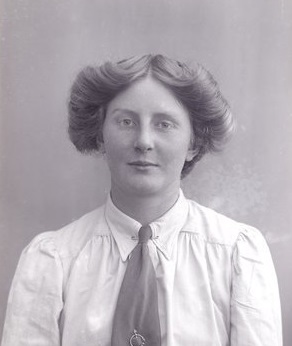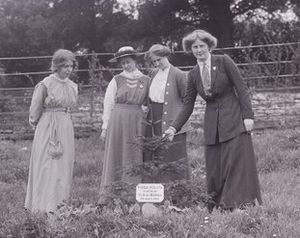Charlotte Marsh facts for kids
Quick facts for kids
Charlotte Marsh
|
|
|---|---|

Charlotte Marsh in 1911
|
|
| Born |
Charlotte Augusta Leopoldine Marsh
3 March 1887 Newcastle upon Tyne, England
|
| Died | 21 April 1961 (aged 74) |
| Nationality | British |
| Occupation | suffrage organiser and activist |
| Years active | 1908– |
| Known for | Organising suffrage demonstrations |
Charlotte "Charlie" Augusta Leopoldine Marsh (born March 3, 1887 – died April 21, 1961) was a brave British activist. She fought for women's right to vote. She was a paid organizer for the Women's Social and Political Union (WSPU). She was also one of the first women to be force-fed while in prison for her protests. During World War I, she worked as a driver and mechanic for David Lloyd George, who later became Prime Minister.
Contents
Early Life
Charlotte Marsh was born on March 3, 1887. Her birthplace was Alnmouth, near Newcastle upon Tyne, England. Her parents were Ellen and Arthur Hardwick Marsh, a famous watercolour painter.
Charlotte went to school locally at St Margaret's School. She also studied at Roseneath in Wrexham. Later, she finished her education in Bordeaux, France.
Fighting for Women's Rights

In 1907, Charlotte Marsh joined the Women's Social and Political Union (WSPU). This group worked hard to get women the right to vote. She became a full-time organizer for the WSPU.
Charlotte helped other suffragettes, like Mary Philips, to spread their message. They would write on pavements to tell people about their cause. Charlotte was known for standing strong even when people made fun of them.
She also took part in public parades. On June 30, 1908, she was arrested with Elsie Howey. They were protesting and were sent to Holloway Prison for a month.
Protests and Hunger Strikes
On September 17, 1909, Charlotte Marsh, Mary Leigh, and Patricia Woodlock climbed onto the roof of Bingley Hall in Birmingham. They were protesting because they were not allowed into a political meeting. The British Prime Minister, Herbert Asquith, was speaking there.
After this protest, Charlotte was sent to Winson Green Prison. To show they were serious, she and the others went on a hunger strike. They wanted to be treated as political prisoners, not criminals. Charlotte, Mary, and Patricia were among the first suffragettes to be force-fed. This meant food was put into their bodies through a tube. Charlotte was reportedly force-fed 139 times during this time in prison.
Eagle House and Recognition
In April 1911, Charlotte Marsh was invited to Eagle House in Batheaston. This was a special place for leading suffragettes. They were invited to plant trees there. Each tree had a plaque to remember the event. Charlotte planted a Picea polita tree.
Charlotte was given a special Hunger Strike Medal for her bravery by the WSPU. This medal honored those who went on hunger strike for their cause.
In 1911, Charlotte refused to fill out the census form. This was another way suffragettes protested against not having the right to vote.
World War I and Beyond
During World War I, Charlotte Marsh took on a new role. She worked as a mechanic and driver for David Lloyd George. He was an important politician at the time. Lloyd George knew about her past as a suffragette. He wanted to show support for women joining the workforce. He also wanted to connect with those who wanted women to vote.
By 1916, Charlotte felt that the WSPU was not focusing enough on women's voting rights during the war. So, she helped start a new group called the Independent Women's Social and Political Union. This group continued to fight for suffrage. They also published a newspaper called Independent Suffragette.
After the War
After the war, Charlotte Marsh continued her work for important causes. She worked for the Women's International League for Peace and Freedom. This group worked for peace around the world. She also became a social worker in San Francisco.
Later, Charlotte returned to London. She used her skills in public health, working for the London County Council. She also helped Edith How-Martyn collect items for the Suffragette Fellowship. This collection helped tell the story of the women's suffrage movement.
In 1952, Charlotte gave a speech at the first meeting of the National Assembly of Women. She spoke about women working together for equality and peace.
Death and Legacy
Charlotte Marsh passed away on April 21, 1961, in London. Her bravery and dedication are remembered. A blue plaque was placed in Dorking to honor Charlotte and other local suffragettes. This happened in 2018, 100 years after some women in Britain gained the right to vote.
Images for kids
-
Procession of Suffragettes on The Strand on 30 June 1908. The Suffragettes are (left to right) Dorothy Hartopp Radcliffe, Dora Spong who appears to be holding a pile of Votes for Women newspapers, Hilda Dallas and Charlotte Marsh carrying the placard
See also
 In Spanish: Charlotte Marsh para niños
In Spanish: Charlotte Marsh para niños


